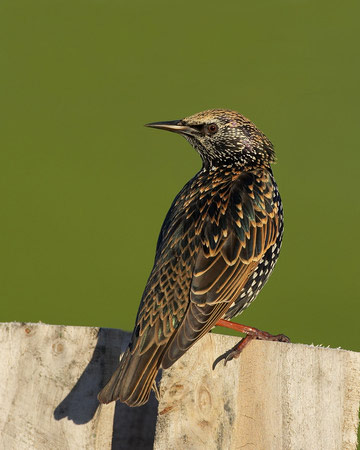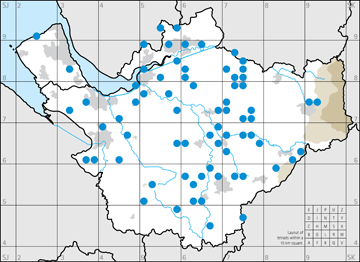
Starling © Richard Steel

Starling roost map.
Our breeding Starlings are mostly sedentary, or make short movements within Britain, but their numbers are augmented in winter by millions of birds from Eastern Europe. Merseyside Ringing Group has 88 records of ringed Starlings overseas, including twelve from as far as Russia, Belarus and the Baltic states. Some of these stay in large flocks in the countryside but others come into gardens and mix with local birds. The Atlas map shows that the winter distribution is similar to that of the breeding season, with the only significant difference being birds present in seven of the tetrads in the eastern hills where they were not found breeding. The habitat codes submitted in winter, however, show a very different distribution from the breeding season, with 60% of the winter records on farmland (including 31% improved grassland), 30% human sites, 7% woodland or scrub, many of these used for roosting, and 3% semi-natural grassland and marsh. The phrase ‘human sites’ does not only mean habitation, and birds were noted in a number of tetrads feeding on landfill sites or sewage farms.
They spend almost all of their lives in groups from a few birds to many thousands. Large feeding flocks are especially a feature of the south of the county, birds foraging on pasture or stubble, particularly favouring recently slurried fields or those used by cattle or sheep. Starlings are wintering in fewer gardens, according to the BTO's Garden Bird Feeding Survey, having fallen from presence in about 85% of gardens in the mid-1990s to 70% now. Similarly, from its inception in 1979 to 2003, the late-January RSPB Big Garden Birdwatch found Starling to be the most numerous bird in gardens, but it no longer holds top spot and the numbers of Starlings per garden are down to less than a quarter of those recorded in 1979. These results do not necessarily imply any change in populations, but could indicate changed feeding habits and less need to visit artificial food sources, especially with warmer winters of late.
Roosting or pre-roosting flocks were reported widely across the county, with some massive counts in the south of the county headed by the half a million birds in Nantwich (SJ65K) in 2004/ 05, up to 300,000 in conifer windbreak trees near Wardle (SJ65D) in 2005/ 06 and 250,000 at Bulkeley (SJ55H) in 2004/ 05. Elsewhere, the Runcorn-Widnes Bridge (SJ58B) has held hundreds of thousands of birds in the past, despite concerted attempts by local authorities at dispersing them, and there were estimated to be up to 70,000 there during this Atlas period, and another traditional site is the reedbed at Rostherne Mere (SJ78L) – mentioned by Coward (1910) – holding a conservatively judged 45,000 in 2006/ 07. Many smaller roosts were reported, often in leylandii, with willows used at Woolston (SJ68P), a plane tree in Warrington town centre (SJ68E), a water tower near Congleton (SJ86Q) and industrial buildings across the county. Large roosts may have a catchment 20 km in radius (BTO Winter Atlas), and the map of reported roost sites is difficult to interpret, amalgamating three winters and ignoring changes within a winter. Coordination of counts and mapping flight-lines to roosts would make an admirable project for CAWOS.
Sponsored by Dr P. Griffiths

